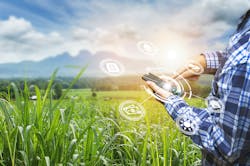The truth behind energy-harvesting sensors
Supplying energy for millions of communicating devices is a key challenge for future-proofing the Industrial Internet of Things (IIoT). Renewable energies, such as sunlight or wind, have been harvested using solar cells and turbines for years.
On a smaller scale, energy harvesting uses small energy converters to harvest energy from movement, light or temperature differences. These amounts of energy are sufficient to power a wireless sensor and to transmit data via radio.
Energy harvesting for radio-based products that are already in mass production uses four different sources:
• motion—the press on a switch, moving machine parts, rotary motion of a handle
• light—the indoor or incoming sunlight in a room
• temperature differences—between a heat source such as a radiator, pipes or boiler and the environment, as well as day-and-night variations
• electromagnetic field—a contactless coil in a cage clamp clipped around a cable powers the meter and measures the line current.
For each of these sources, there are different energy converters with different power parameters. The type of energy generation together with the corresponding power yield decisively determines the possible sensor applications.
Energy from motion: This principle uses the power of motion to generate energy for wireless signals. When pressing a switch, for example, an electromechanical energy converter is activated and uses this movement to generate energy for a telegram. This telegram can turn on/off household appliances or a light or create different scenes for LED lights. The same functionality can be used for a kinetic window contact, which registers if a window is open or closed, or a self-powered water sensor. Here, the energy converter is activated when water gets in touch with the swelling material on the sensor’s bottom. The sensor, positioned below the bathtub or the washing machine, can now send a wireless signal to prevent water damage.
Energy from light: Wherever there is light, even at low level of 200 lux or less, tiny solar cells can harvest this source of energy for a broad range of batteryless sensors. This includes temperature sensors, CO2 sensors, occupancy sensors, solar-powered window contacts or humidity sensors.
Energy from temperature: A temperature difference of already 2 °C delivers enough energy for electronic devices, enabled by the combination of a dc/dc converter and a Peltier element. This harvesting technology operates self-powered heating valves, for example, which use the difference in temperature between the heating radiator and the environment to provide energy for changes in stroke, as well as for wireless communication with a solar-powered room controller.
Also read: Wireless sensors for applications in impractical locations
Improved sustainability
Thanks to energy harvesting technology, radio sensors are becoming sustainable because they don’t need cabling or battery power, which is environmentally friendly and saves costs. Resource saving and environmental protection are also becoming increasingly important. Wireless energy-harvesting sensors are a sustainable solution that take both the financial aspect and the effects on the environment into account.
In operation for the industry
Sensors have a key function in industrial production. By combining energy-saving radio with local energy converters, battery-free sensors can also be mounted directly on moving parts or in hermetically sealed environments, for example, for measuring the position of mechanical parts, the current consumption or the temperature of mechanical parts, liquids or gases.
Automated monitoring systems need data generated by sensors that fit seamlessly into production processes. Early identification of problems and appropriate countermeasures are important prerequisites for continuous quality assurance and protection against production downtime.
It's possible to gain information by monitoring a few parameters. For example, a rise in temperature can indicate higher friction and thus wear. Wireless temperature sensors can be used for the measurement processes. Humidity sensors monitor whether water is leaking to prevent water damage. Temperature and humidity sensors also provide information on air conditions to ensure consistent air quality.
Wireless energy-harvesting sensors are maintenance-free, flexible and inexpensive to install. Typically, a battery-powered sensor costs between $25, if all batteries are changed at the same time, and $260, if batteries are exchanged one at a time, per sensor per year.
Also read: Harvest energy from sensors for reduced maintenance and improved safety
IIoT in the factory
In manufacturing, the IIoT enables efficient, flexible and individualized production. Quality monitoring and assurance play key roles in the production process. It is crucial to ensure that the end product complies with the previously defined parameters. Changing environmental factors such as temperature, humidity and air quality can result in significant deviations in quality. That is why the so-called golden batch is relevant in manufacturing. This concept involves identifying the precise environmental conditions in which the best batch was produced. To accomplish this, process values must be recorded over time and the data analyzed in order to determine the critical variables and then reproduce them consistently.
Sensor installations are flexible, as the sensors can be placed exactly where they are needed due to being completely wireless and battery-free. Individualized production means determining the best conditions possible in terms of air quality and light with data from the energy-harvesting sensors. These conditions are very individual, depending on what is being produced.
With the help of sensors networked with an IIoT platform, it is even possible to create a digital twin, an exact virtual image of a machine throughout its entire lifecycle.
For the digitalization of buildings and related processes, the raw data from sensors is an important component. As digital sensory organs, they provide the information for further processing in the cloud, for example, to be able to digitally map entire buildings or individual areas, the so-called digital twin. A digital twin depicts an object or process from the real world. It represents the characteristics and behaviors of the real building or process as precise as possible. The object may already exist, but it can also be a future plan.
About the Author

Armin Anders, EnOcean
Armin Anders is co-founder and vice president of business development at EnOcean.

Leaders relevant to this article:
